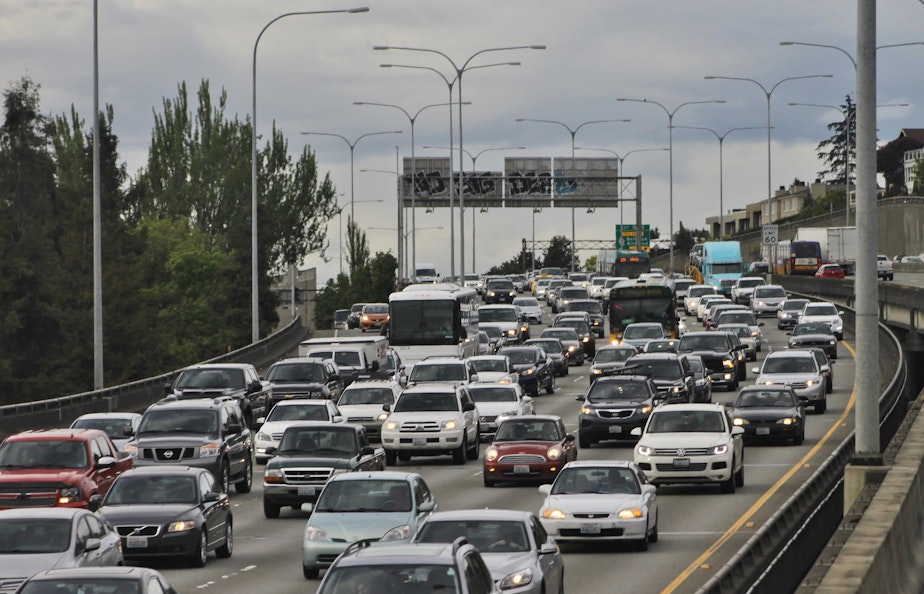A new tool suggests we're underestimating the environmental cost of new roads

The infrastructure bill being hammered out in D.C. will fund a lot of road projects, including some in Washington State.
But it's difficult to reduce our carbon emissions when we keep building more highways.
That's what inspired a network of environmental groups to build a calculator that shows how much air pollution is caused by new roads.
Paulo Nunes-Ueno is with the Seattle-based group Front and Centered, which focuses on social justice for low-income and BIPOC communities. He said those communities needed a tool like this calculator to help them lobby for transit projects instead of roads.
“One in eight women in Washington state have asthma, one of the highest rates in the country,” he said. “And we need to start making those linkages, between the 50- or 60- or 70-year investments that we make in transportation infrastructure and our communities’ health. We can’t be doing this blindly anymore.”
The calculator is based on research out of the Institute for Transportation Studies at the University of California, Davis. The tool was originally built to analyze California projects, but the non-profit, Colorado-based Rocky Mountain Institute expanded the caluclator to cover all 50 states and released it this week. Front and Centered is promoting the tool's use in Washington state.
Rosalinda Guillen is a 70-year-old Skagit Valley farmworker and community leader coordinating with Front and Centered. She hopes the tool will help lawmakers understand the health impacts on low-income communities that live near highways, such as farmworkers in and around Mt. Vernon, Washington.
“Don’t think just about moving cars around, and moving more cars to destinations," she said. "For us, the place where you’re building the road is our destination. That is our home, that is our recreational area, it’s our workspace, because we’re outdoor workers. You are poisoning our space.”
Sponsored
One major argument against building roads is their potential to get in the way of meeting climate goals. The calculator attempts to figure out if they do, by predicting what could happen under two scenarios — if we manage to dramatically speed up the switch from gas power cars to electric — and if we continue depending on cars that use gas.
I plugged a couple local projects into the calculator: extensions to State Route 167 and 509, due for completion in 2028. Combined, these projects are called “The Puget Sound Gateway Program,” and they're meant to improve access to our region’s ports by keeping cars and trucks out of each others’ hair. In total, the projects would add roughly two lanes of highway over 9 miles – totaling 18 miles of vehicle lanes.
The calculator said if those lanes were built today, they’d create between 0.1 and 0.3 million metric tons of CO2 into the atmosphere between now and 2050; depending on how quickly we electrify the vehicles we drive.
Laura Newborn is a spokesperson for Washington State’s transportation department. She disputes those numbers, citing official environmental impact analyses that say the Gateway projects would actually reduce pollution.
“You can’t negate the fact that you have traffic there now — trucks and cars, idling in traffic.” The new roads would better separate truck traffic trying to access the Ports of Tacoma and Seattle from the stream of cars, Newborn said. “And because this is a relief valve for that, you will have less pollution as a result.”
Sponsored
Jamey Volker, one of the researchers at the UC Davis Institute of Transportation Studies, said many state analyses of environmental impacts for highway projects cannot be taken at face value. He recently analyzed environmental impact statements for five California highway projects, and found they did not properly account the way traffic tends to bounce back on some projects not long after new lanes are built. He said he hasn’t looked at studies from Washington state.
If you build it, they will come
Whether or not specific projects do in fact reduce pollution, researchers generally agree that in congested areas, building more lanes doesn’t make traffic problems go away. The reason is that new, empty traffic lanes inspire more people to drive. And so, gains in efficiency from reduced congestion — are quickly erased.
This principle is called "Latent Demand,” or “Induced Travel,” depending on which researcher you’re talking to. Or you could just call it the "if you build it, they will come" principle.
Mark Hallenbeck, director of the Washington State Transportation Center at the University of Washington, explains it like this: “In places where there is lots of congestion, people don’t find the activity they’d like to perform worth putting up with the traffic, so they don’t do it,” he said. “'I don’t want to go see the Mariners play, because traffic to downtown sucks!’ So they don’t go.”
Sponsored
Building a new road or a new train line makes it easier to get to the game, Hallenbeck said, “and they now choose to go do those activities.”
Hallenbeck wasn’t confident, however, that the calculator does enough to account for local variations. For example, if a road leads to a new park, or a new housing development, its lanes may quickly fill with traffic, but “building lanes in South Dakota or Nebraska will not generate the growth in vehicle miles traveled that their calculator predicts, because not enough people are interested in developing land in those areas.”




